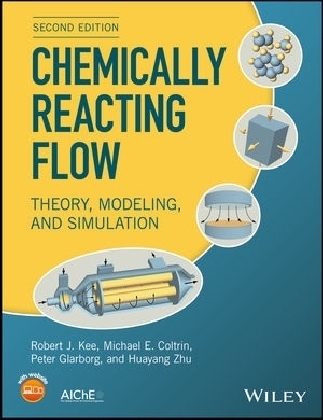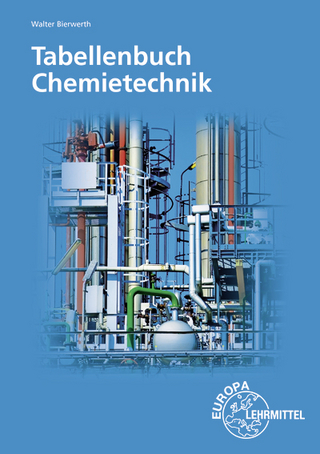
Chemically Reacting Flow
John Wiley & Sons Inc (Verlag)
978-1-119-18487-4 (ISBN)
Chemically Reacting Flow: Theory, Modeling, and Simulation, Second Edition combines fundamental concepts in fluid mechanics and physical chemistry while helping students and professionals to develop the analytical and simulation skills needed to solve real-world engineering problems. The authors clearly explain the theoretical and computational building blocks enabling readers to extend the approaches described to related or entirely new applications. New to this Second Edition are substantially revised and reorganized coverage of topics treated in the first edition. New material in the book includes two important areas of active research: reactive porous-media flows and electrochemical kinetics. These topics create bridges between traditional fluid-flow simulation approaches and transport within porous-media electrochemical systems.
The first half of the book is devoted to multicomponent fluid-mechanical fundamentals. In the second half the authors provide the necessary fundamental background needed to couple reaction chemistry into complex reacting-flow models. Coverage of such topics is presented in self-contained chapters, allowing a great deal of flexibility in course curriculum design.
• Features new chapters on reactive porous-media flow, electrochemistry, chemical thermodynamics, transport properties, and solving differential equations in MATLAB
• Provides the theoretical underpinnings and practical applications of chemically reacting flow
• Emphasizes fundamentals, allowing the analyst to understand fundamental theory underlying reacting-flow simulations
• Helps readers to acquire greater facility in the derivation and solution of conservation equations in new or unusual circumstances
• Reorganized to facilitate use as a class text and now including a solutions manual for academic adopters
Computer simulation of reactive systems is highly efficient and cost-effective in the development, enhancement, and optimization of chemical processes. Chemically Reacting Flow: Theory, Modeling, and Simulation, Second Edition helps prepare graduate students in mechanical or chemical engineering, as well as research professionals in those fields take utmost advantage of that powerful capability.
Robert J. Kee, PhD, is the George R. Brown Distinguished Professor of Engineering at the Colorado School of Mines in Golden, Colorado. Michael E. Coltrin, PhD, is a Distinguished Member of the Technical Staff at Sandia National Laboratories, Albuquerque, New Mexico. Peter Glarborg, PhD, is a Professor of Chemical Engineering at the Technical University of Denmark in Lyngby, Denmark. Huayang Zhu, PhD, is a Research Professor of Mechanical Engineering at the Colorado School of Mines, Golden, Colorado.
Preface xxi
Acknowledgments xxv
1 Introduction 1
1.1 Foregoing Texts 2
1.2 Objectives and Approach 3
1.3 What is a Fluid? 3
1.4 Chemically Reacting Fluid Flow 8
1.5 Physical Chemistry 9
1.6 Illustrative Examples 10
References 17
2 Fluid Properties 21
2.1 Equations of State 21
2.2 Thermodynamics 25
2.3 Transport Properties 31
References 42
3 Fluid Kinematics 45
3.1 Path to Conservation Equations 46
3.2 System and Control Volume 48
3.3 Stress and Strain Rate 58
3.4 Fluid Strain Rate 59
3.5 Vorticity 68
3.6 Dilatation 69
3.7 Stress Tensor 70
3.8 Stokes Postulates 79
3.9 Transformation from Principal Coordinates 83
3.10 Stokes Hypothesis 88
3.11 Summary 88
4 Conservation Equations 91
4.1 Mass Continuity 93
4.2 Navier–Stokes Equations 97
4.3 Species Diffusion 104
4.4 Species Conservation 108
4.5 Conservation of Energy 114
4.6 Mechanical Energy 123
4.7 Thermal Energy 124
4.8 Ideal Gas and Incompressible Fluid 130
4.9 Conservation Equation Summary 130
4.10 Pressure Filtering 132
4.11 Helmholtz Decomposition 135
4.12 Potential Flow 136
4.13 Vorticity Transport 137
4.14 Mathematical Characteristics 142
4.15 Summary 148
References 148
5 Parallel Flows 151
5.1 Nondimensionalization 152
5.2 Couette and Poiseuille Flows 154
5.3 Hagen–Poiseuille Flow in a Circular Duct 167
5.4 Ducts of Noncircular Cross Section 170
5.5 Hydrodynamic Entry Length 174
5.6 Transient Flow in a Duct 175
5.7 Richardson Annular Overshoot 175
5.8 Stokes Problems 178
5.9 Rotating Shaft in Infinite Media 188
5.10 Graetz Problem 189
References 193
6 Similarity and Local Similarity 195
6.1 Jeffery–Hamel Flow 196
6.2 Planar Wedge Channel 196
6.3 Radial-Flow Reactors 205
6.4 Spherical Flow between Inclined Disks 206
6.5 Radial Flow between Parallel Disks 209
6.6 Flow between Plates with Wall Injection 214
References 224
7 Stagnation Flows 225
7.1 Similarity in Axisymmetric Stagnation Flow 226
7.2 Generalized Steady Axisymmetric Stagnation Flow 228
7.3 Semi-Infinite Domain 232
7.4 Finite-Gap Stagnation Flow 242
7.5 Finite-Gap Numerical Solution 252
7.6 Rotating Disk 255
7.7 Rotating Disk in a Finite Gap 260
7.8 Unified View of Axisymmetric Stagnation Flow 265
7.9 Planar Stagnation Flows 270
7.10 Opposed Flow 273
7.11 Tubular Flows 274
7.12 Stagnation-Flow Chemical Vapor Deposition 280
7.13 Boundary-Layer Bypass 285
References 287
8 Boundary-layer Channel Flow 291
8.1 Scaling Arguments for Boundary Layers 292
8.2 General Setting Boundary-Layer Equations 298
8.3 Boundary Conditions 299
8.4 Computational Solution 300
8.5 Introduction to the Method of Lines 302
8.6 Method-of-Lines Boundary-Layer Algorithm 304
8.7 Von Mises Transformation 308
8.8 Von Mises Formulation as DAEs 311
8.9 Hydrodynamic Entry Length 314
8.10 Physical and von Mises Coordinates 314
8.11 General von Mises Boundary Layer 315
8.12 Limitations 317
8.13 Chemically Reacting Channel Flow 318
References 319
9 Low-dimensional Reactors 323
9.1 Batch Reactors (Homogeneous Mass-Action Kinetics) 324
9.2 Plug-Flow Reactor 327
9.3 Plug Flow with Porous Walls 331
9.4 Plug Flow with Variable Area and Surface Chemistry 333
9.5 Perfectly Stirred Reactors 338
9.6 Transient Stirred Reactors 341
9.7 Stagnation-Flow Catalytic Reactor 345
References 346
10 Thermochemical Properties 347
10.1 Kinetic Theory of Gases 348
10.2 Molecular Energy Levels 349
10.3 Partition Function 353
10.4 Statistical Thermodynamics 359
10.5 Example Calculations 366
References 369
11 Molecular Transport 371
11.1 Introduction to Transport Coefficients 372
11.2 Molecular Interactions 375
11.3 Kinetic Gas Theory of Transport Properties 384
11.4 Rigorous Theory of Transport Properties 391
11.5 Evaluation of Transport Coefficients 399
11.6 Momentum and Energy Fluxes 406
11.7 Species Fluxes 406
11.8 Diffusive Transport Example 413
References 415
12 Mass-action Kinetics 417
12.1 Gibbs Free Energy 418
12.2 Equilibrium Constant 422
12.3 Mass-Action Kinetics 427
12.4 Pressure-Dependent Unimolecular Reactions 433
12.5 Bimolecular Chemical Activation Reactions 438
References 443
13 Reaction Rate Theories 445
13.1 Molecular Collisions 446
13.2 Collision Theory Reaction Rate Expression 453
13.3 Transition-State Theory 457
13.4 Unimolecular Reactions 461
13.5 Bimolecular Chemical Activation Reactions 474
References 480
14 Reaction Mechanisms 481
14.1 Models for Chemistry 482
14.2 Characteristics of Complex Reactions 486
14.3 Mechanism Development 493
14.4 Combustion Chemistry 503
References 518
15 Laminar Flames 521
15.1 Premixed Flat Flame 521
15.2 Premixed Flame Structure 530
15.3 Methane-Air Premixed Flame 534
15.4 Stagnation Flames 534
15.5 Opposed-Flow Diffusion Flames 536
15.6 Premixed Counterflow Flames 539
15.7 Arc-Length Continuation 543
References 545
16 Heterogeneous Chemistry 549
16.1 Taxonomy 550
16.2 Surface Species Naming Conventions 553
16.3 Concentrations within Phases 555
16.4 Surface Reaction Rate Expressions 557
16.5 Thermodynamic Considerations 565
16.6 General Surface Kinetics Formalism 571
16.7 Surface-Coverage Modification of the Rate Expression 573
16.8 Sticking Coefficients 574
16.9 Flux-Matching Conditions at a Surface 576
16.10 Surface Species Governing Equations 577
16.11 Developing Surface Reaction Mechanisms 578
References 587
17 Reactive Porous Media 589
17.1 Introduction 589
17.2 Pore Characterization 591
17.3 Multicomponent Transport 593
17.4 Mass Conservation Equations 597
17.5 Energy Conservation Equations 598
17.6 Tubular Packed-Bed Reactor 600
17.7 Reconstructed Microstructures 603
17.8 Intra-Particle Pore Diffusion 607
References 609
18 Electrochemistry 613
18.1 Electrochemical Reactions 615
18.2 Electrochemical Potentials 618
18.3 Electrochemical Thermodynamics and Reversible Potentials 618
18.4 Electrochemical Kinetics 621
18.5 Electronic and Ionic Species Transport 632
18.6 Modeling Electrochemical Unit Cells 633
18.7 Principles of Composite SOFC Electrodes 641
18.8 SOFC Button-Cell Example 643
18.9 Chemistry and Model Development 647
References 649
A Vector and Tensor Operations 651
A. 1 Vector Algebra 651
A. 2 Unit Vector Algebra 652
A. 3 Unit Vector Derivatives 653
A. 4 Scalar Product 653
A. 5 Vector Product 654
A. 6 Vector Differentiation 654
A. 7 Gradient 654
A. 8 Gradient of a Vector 655
A. 9 Curl of a Vector 656
A. 10 Divergence of a Vector 656
A. 11 Divergence of a Tensor 657
A. 12 Laplacian 658
A. 13 Laplacian of a Vector 658
A. 14 Vector Derivative Identities 660
A. 15 Gauss Divergence Theorem 661
A. 16 Substantial Derivative 661
A.6. 1 Substantial Derivative of a Vector 662
A. 17 Symmetric Tensors 662
A. 18 Stress Tensor and Stress Vector 663
A. 19 Direction Cosines 664
A. 20 Coordinate Transformations 665
A. 21 Principal Axes 667
A. 22 Tensor Invariants 669
A. 23 Matrix Diagonalization 670
B Navier–stokes Equations 671
B. 1 General Vector Form 671
B. 2 Stress Components 672
B. 3 Cartesian Navier–Stokes Equations 674
B. 4 Cartesian Navier–Stokes, Constant Viscosity 675
B. 5 Cylindrical Navier–Stokes Equations 675
B. 6 Cylindrical Navier–Stokes, Constant Viscosity 676
B. 7 Spherical Navier–Stokes Equations 676
B. 8 Spherical Navier–Stokes, Constant viscosity 677
B. 9 Orthogonal Curvilinear Navier–Stokes 678
C Example in General curvilinear coordinates 681
C.1 Governing Equations 681
C.1.1 Limiting Cases 685
d Small Parameter Expansion 687
E Boundary-layer Asymptotic Behavior 691
E. 1 Boundary-Layer Approximation 692
E. 2 A Prototype for Boundary-Layer Behavior 693
F Computational Algorithms 697
F. 1 Differential Equations from Chemical Kinetics 698
F. 2 Stiff Model Problem 698
F. 3 Solution Methods 700
F.3. 1 Explicit Methods 701
F.3. 2 Implicit Methods 704
F. 3 Stiff ODE Software 707
F. 4 Differential-Algebraic Equations 707
F. 5 Solution of Nonlinear Algebraic Equations 708
F.5. 1 Scalar Newton Algorithm 708
F.5. 2 Newton’s Algorithm for Algebraic Systems 709
F.5. 3 Illustration of the Hybrid Method 712
F.5. 4 Steady-State Sensitivity Analysis 713
F. 6 Continuation Procedures 715
F.6. 1 Multiple Steady States 715
F.6. 2 Illustration of Spurious Solutions 715
F. 7 Transient Sensitivity Analysis 717
F. 8 Transient Ignition Example 719
References 719
G MATLAB Examples 721
G. 1 Steady-State Couette–Poiseuille Flow 721
G. 2 Steady Semi-Infinite Stagnation Flow 723
G. 3 Steady Finite-Gap Stagnation Flow 725
G. 4 Transient Stokes Problem 728
G. 5 Graetz Problem 729
G. 6 Channel Boundary Layer Entrance 731
G. 7 Rectangular Channel Friction Factor 735
Index 739
| Erscheinungsdatum | 29.10.2017 |
|---|---|
| Verlagsort | New York |
| Sprache | englisch |
| Maße | 178 x 259 mm |
| Gewicht | 1565 g |
| Themenwelt | Naturwissenschaften ► Chemie ► Technische Chemie |
| Technik ► Maschinenbau | |
| Technik ► Umwelttechnik / Biotechnologie | |
| ISBN-10 | 1-119-18487-8 / 1119184878 |
| ISBN-13 | 978-1-119-18487-4 / 9781119184874 |
| Zustand | Neuware |
| Haben Sie eine Frage zum Produkt? |
aus dem Bereich


